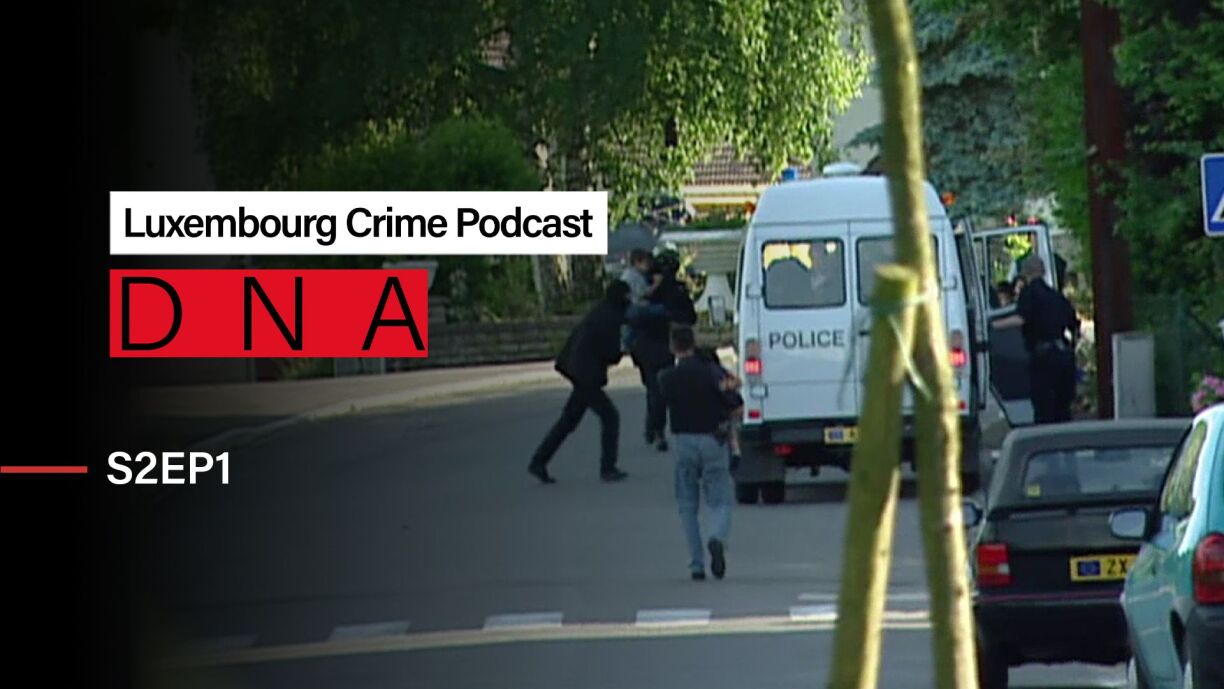
On 31 May 2000, the quiet riverside town of Wasserbillig suddenly became the centre of global media attention. Special police forces, emergency vehicles and satellite television vans piled up in the town, a police helicopter hovered above the centre, as hundreds of journalists and members of the public from Luxembourg and abroad gathered around one building.
At 3.35pm that afternoon, a 39-year-old gunman carrying a pistol, a knife, a petrol tank and a hand grenade entered the Spatzennascht crèche of Wasserbillig. He locked up the building, with 5 teachers and 43 children inside, the latter aged between 2-10, and of Luxembourgish, Portuguese, German and French nationality.
Listen to episode 1 of the new season of DNA: Luxembourg Crime Podcast:
Neji Bejaoui stormed into the Spatzennascht crèche in Wasserbillig and took 45 children and 5 educators hostage.
Parents of the children were called to the nearby cultural centre, where they were accompanied by psychologists. The cultural centre had a direct line of sight with the crèche, giving parents a sense of comfort. As new details emerged from the kidnapping, information was written up on a flip chart for all parents to see.
The kidnapper was the 39-year-old Neji Bejaoui, a troubled and abusive man who saw his family fall apart. After losing custody of his children in a divorce and failing to pay their crèche fees, he wanted revenge.
His demands? A Cargolux plane taking him to Libya, as well as 6 million Luxembourgish francs. In an interview given to RTL on the second day of the kidnapping, Bejaoui said: “I can’t bear life any more and I can’t face people. I swear on my mother’s head that I love children, but they took my children away and I have taken the children of others. It’s tit for tat.”
No one knew how long the hostage taking would last. Meanwhile, CNN and BBC news trucks pulled up outside, as well as 50 ambulances – one for every child, should the worst come to happen.
When Bejaoui sought live airtime on TV, police saw an opportunity to prepare a possible intervention. This was the first time Bejaoui was stepping outside of the crèche and away from most of the children and teachers. Two police officers would pose as the RTL journalists.
At 7.16pm on Thursday, 1 June, Bejaoui came out of the creche holding a grenade in one hand with a child, and a teacher in the other. He stepped forward and began speaking to the RTL journalists. The RTL journalists in disguise.
Everything unfolded in just a few seconds: The TV camera was actually a disguised gun. The marksman, posing as the camera operator, was a trained policeman, who fired two shots at close range at Bejaoui’s head. Bejaoui fell backwards, with the grenade and child still in both arms. Units rushed forward to rip the child away from him, as a special bomb squad professional jumped on Bejaoui should the grenade explode. But there was no explosion. The pin had never been removed.
Immediately as the shots were fired, special units and emergency service personnel rushed into the daycare centre and carried all the children safely out of the building. Staff were in tears, but safe.
Bejaoui was critically injured and hospitalised. After 28-hours, the attack came to an end. No lives were lost.
There was a lot of debate surrounding the tactics used by Luxembourg’s police. Following the events, The New York Times reported that the world’s largest journalists’ organisation has asked for an investigation of Luxembourg police tactics after officers posed as a television crew and lured a gunman into an ambush to end a hostage crisis.
''These are disturbing tactics,’' cautioned Aidan White, general secretary of the Brussels-based International Federation of Journalists, which represents more than 450,000 journalists worldwide. He added: “Cameramen are always potential targets when filming in dangerous conditions. Incidents like this may put them at even more risk from trigger-happy criminals or security forces who may suspect their motives.
Fred Brown, chairman of the Society for Professional Journalists’ Ethics Committee, said the case ''just adds to the sense that journalists are not always what or who they appear to be.’'
The Luxembourg police defended their strategy, however, saying it minimised the threat to the hostages and led to their release unharmed.
At least one journalism professor, Nicholas Daniloff of Northeastern University, agreed. ''This was a question of saving lives,’' he said. ''You can argue that the results justified what was done.’'
Bejaoui faced a number of charges, including suppression of individual freedom, extortion, deliberate injury to others, not respecting the law on arms, and the triple rape of one teacher.
His trial, before a judicial panel, was held in October of 2001. A psychiatrist who examined him in prison described Bejaoui as a depressive paranoiac – saying he had developed a hatred for the Justice system and society because of perceived injustices – a reference to Bejaoui’s losing custody of his children many years earlier.
Neji Bejaoui was sentenced to 22 years in prison – with the possibility of four years parole if he undergoes a programme of psychiatric treatment. Judge Prosper Klein also ordered Bejaoui to pay thousands of dollars to families and workers at the day care centre.
Bejaoui was released in 2016. The victims of the hostage taking were informed about his release in advance. In a Luxemburger Wort interview with one of the held children at the time, Jennifer Caprasse said: “That was not easy for us. It was hard. Some families could not cope with this news. We have experienced traumatic things, and it was hard to fathom that he was given so much understanding.”
According to justice officials, Bejaoui resides in Luxembourg to this day. The Spatzennascht still exists today.